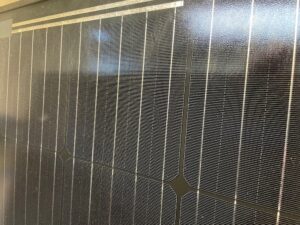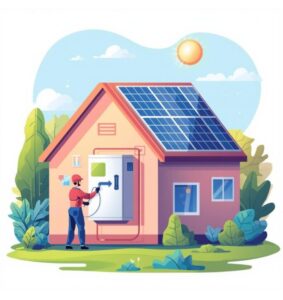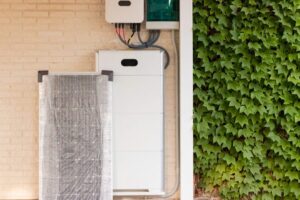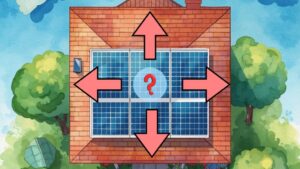When you first see the term “busbar” you may think it’s the newest evolution to a pub crawl; a type of bus with a bar in it for anyone that catches a ride. Well, it may shock you to learn it’s actually a piece of electrical equipment. A piece that plays an important role in transporting electricity from one place to another in a safe manner. Without further ado, let’s get right into it.
What are Busbars?
Busbars are often thin strips, bars, or tubes made out of a metal optimized for carrying electrical currents between different points. Although more expensive than a wiring harness, busbars last longer and distribute power more efficiently; less power loss due to distribution, means more available at the endpoint (i.e. your home). In general, busbars can also weather temperature changes better than electrical components, making them a perfect solution for renewable energy integration.
What do Busbars do in Solar panels?
In solar panels, busbars are the thin rectangular strips that separate solar cells and conduct electricity. It takes the electrons, once separated from photons by the solar cells, and transfers them to the panel’s inverter. From there the electricity created from the moving electrons is converted from Direct Current (DC) into Alternating Current (AC), powering the home (more about how solar panels work here). In addition to distribution, busbars help reduce resistance. By reducing the resistance within the interconnection of solar cells, less electricity is lost in the form of heat.
Busbar’s Mini-Me
In addition to busbars, solar panels have these even thinner strips called fingers. Solar cell fingers provide much of the same benefit of busbars but on micro-level; they serve as mini busbars for solar cells while busbars serve the entire panel. Because the solar fingers are significantly thinner, they take up less space which means more room for solar cells and they create less shade which means more sunlight on the solar cells. This shouldn’t suggest busbars are less valuable. In fact, busbars can carry a greater amount of current making them indispensable for yielding an energy production.
So, the more busbars the better?
Not necessarily. There are a few factors that can make busbars more cumbersome than useful. For starters, a small solar panel would be better off maximizing space with solar cells. More busbars means more material in a panel that doesn’t generate electricity; that means more weight per a panel and more cost per a panel.
Additionally, if you live somewhere cold like, Winnipeg Canada, you’re less likely to need a lot of busbars because the lower external temperatures reduces the resistance. So imagine this, it’s a hot summer day and your solar panels are basking in the sunlight. This means more voltage, whoo hoo! We’ve got power baby! But your solar panels only have three busbars. That’s like living in San Antonio with only one highway during rush hour – yikes. So much of that electricity will be lost in the form of heat because the electrons can’t travel fast enough with an increase in resistance. More resistance, i.e. the fewer busbars, the more electrons will be dissipated in the form of heat. This may not matter if you live in Winnipeg, Canada or somewhere else cold, but if you live somewhere hot like San Antonio, TX where temperatures are fairly high and there can be over 12hrs of sunlight a day, resistance will increase and ultimately lead to a less efficient solar panel system.
Another downside to more busbars is the soldering process. Sticking those strips of metal to the solar panel can create microcracks in the solar cells. The expanding and contracting strips of metal also cause movement within the solar panel that may increase the microcracks. But I mean, if you live in Texas, those solar panels are gonna go through hell and back on your roof… shouldn’t really be a factor in deciding which type of panel should be on your roof. Unless you’re interested in solar panels that don’t have any busbars.

The final issue with lots of busbars is the shiny reflective look that many find to be unsightly on their roof. Many homeowners rather a cleaner, more aesthetically pleasing type of panel when given the option. That’s why manufacturers have turned to a new design of solar panels.
Rear-Contact Solar Cells
A few solar panel manufacturers like REC have no visible busbars and instead use interdigitated back contact (IBC) technology to channel the electricity to your home. Essentially, their reliance on complex pattern and razor thin busbars placed behind the solar cells result in less shading and a cleaner look, while still having plenty of busbars available for those sunny days. IBC solar panels are a relatively new advancement at the time of this writing that offers a more aesthetically pleasing panel without sacrificing efficiency.
On paper, these panels completely smoke the traditional solar panel design.
In terms of production efficiency, design, warranties, temperature coefficient, annual degradation and many other factors shown on a spec sheet, they outperform their predecessor, making it no surprise many IBC panels are considered tier one solar panels and come at a higher price.
However, solar installers do have their concerns. For starters, IBC panels are delicate. Thinner, smaller, and more intricate, components in these newer panels make them more susceptible to getting damaged before, during, and after install. Many of them boast high rating ability to withstand hail. They come with the same 25-year equipment warranty with some offering 30-year as well as a 30-year workmanship warranty in one case. In terms of “breakage,” equipment warranties rarely cover anything outside of the “natural degradation” of components. So is solar panel fragility a necessary concern for a savvy homeowner?
Before we answer that, let’s explore why IBC solar panels have greater fragility to help you determine if it’s something to be concerned about in your specific situation:
Thinner Backing
In traditional solar panels, there’s a white substrate that covers the rear side of the solar cells. While many IBC solar panels have a similar substrate, the material used is thinner to reduce weight and improve the panel’s flexibility. This leaves the panels more susceptible to damage from the point of development to the time of installation.

Thinner Solar Cell Fingers
As mentioned above, IBC solar panels still have busbars and fingers, but they’re placed behind the solar cells. A necessary part to keep the distribution of electricity efficient requires thinner busbars and solar cell fingers. Although more efficient, these thinner strips of metal can be easily damaged during the manufacturing process and installation.
Essentially, so long as your panels are working properly as soon as you have access to their monitoring portal, you’ll know if something’s broken. It can take a few days upon commissioning for your panels to report accurate status. For example, homeowners may see different production/consumption amounts from us for the first three days. After that, the numbers will be accurately calibrated.
Solar Edge Pros Experience
From our experience at Solar Edge Pros, in the past four years of solar panel installs comparing Enphase systems with IBC panels compared to traditional panels, IBCs tend to outperform traditional by 1-to-10 percent in terms of energy production. Full disclosure: this was done using a very small sample size of REC panels as those are the only ones we install regularly.
IBC panels are relatively new, so we’ve been hesitant about promoting them; we’re familiar with traditional types and their ability to withstand Texas weather. I had to compare some systems of roughly the same size installed a few years apart, and wanted to keep the inverter consistent across systems. It’s also important to remember there are a lot of factors that impact energy production excluding the solar panel that we can’t control, e.g. roof pitch, panel orientation, and shading to name a few.
Hopefully, now you understand the importance of busbars and why some panels appear to not have them. Those thin metal strips and their little mini-me’s help keep your system efficient and durable!





